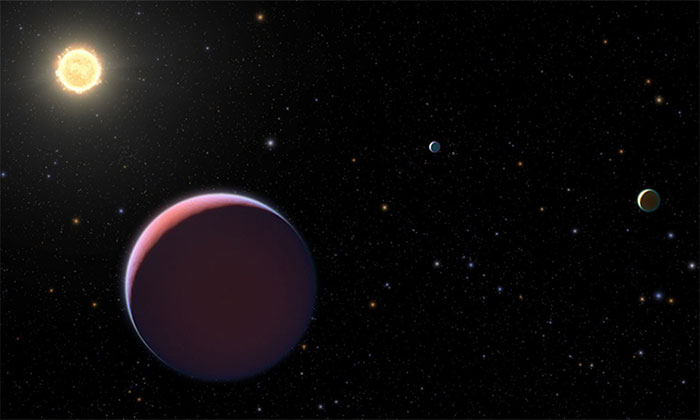'Extraterrestrial' exoplanet discovered as dense as cotton candy
Astronomers found nearly 15 exoplanets in the Kepler 51 star system with a density of less than 0.1 grams of matter per cubic centimeter.
The exoplanets were discovered based on data from NASA's Hubble Space Telescope. They are about the size of Jupiter but are only one-hundredth the mass, lead researcher Jessica Libby-Roberts from the University of Colorado Boulder, USA, said in a statement.

Graphics simulating the Kepler 51 star system. (Image: NASA / ESA)
The team tried to look deeper into the planets' atmospheres but encountered a problem: their atmospheres were not transparent but covered with a layer of opaque. They also tried to search for water but could not observe signs of any molecule.
Using computer simulations and other tools, astronomers hypothesized that Kepler 51's exoplanet is composed primarily of hydrogen and helium. The light properties of these two gases create a super-bulky structure like a cotton candy. However, the surface of the exoplanets seems to be covered by a dense layer of clouds made up of methane gas.
"This is an example of how incredible extrasolar planets are. They offer the opportunity to study things that are very different from ours," says Zachory Berta-Thompson, co-author. of the study said.
The Kepler 51 star system is about 2,400 light-years from Earth and is relatively young, only about 500 million years. The study of exoplanets may provide clues about the origin of the solar system as well as life on Earth.
The team's findings were published in the Astronomical Journal.
- How has cotton candy become popular by a dentist?
- Cotton candy maker creates wound healing material
- One hundred million cotton candy lobster has one
- Planets bear thousands of billions of lightning every hour and clues about aliens
- Do you know what part of the Tic Tac candy box lid is used?
- American fishermen caught super rare cotton candy lobsters
- Why do some types of cotton swabs have 2 different round and pointed heads?
- The unbelievable truth about unique cotton plants in Vietnam
- The giant gas planet only takes 18 hours to orbit the host star
- How to choose a safe cotton swab
- Detecting the youngest alien planet
- Saving water for cotton plants
 Van Allen's belt and evidence that the Apollo 11 mission to the Moon was myth
Van Allen's belt and evidence that the Apollo 11 mission to the Moon was myth The levels of civilization in the universe (Kardashev scale)
The levels of civilization in the universe (Kardashev scale) Today Mars, the sun and the Earth are aligned
Today Mars, the sun and the Earth are aligned The Amazon owner announced a secret plan to build a space base for thousands of people
The Amazon owner announced a secret plan to build a space base for thousands of people